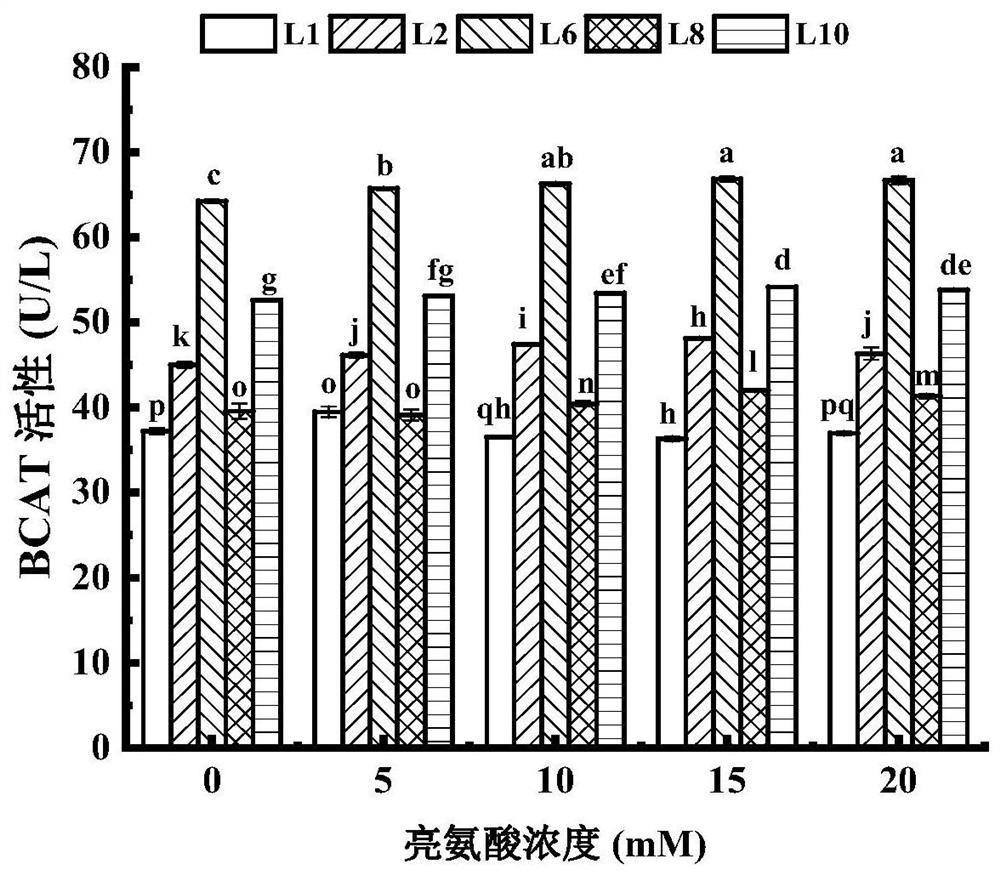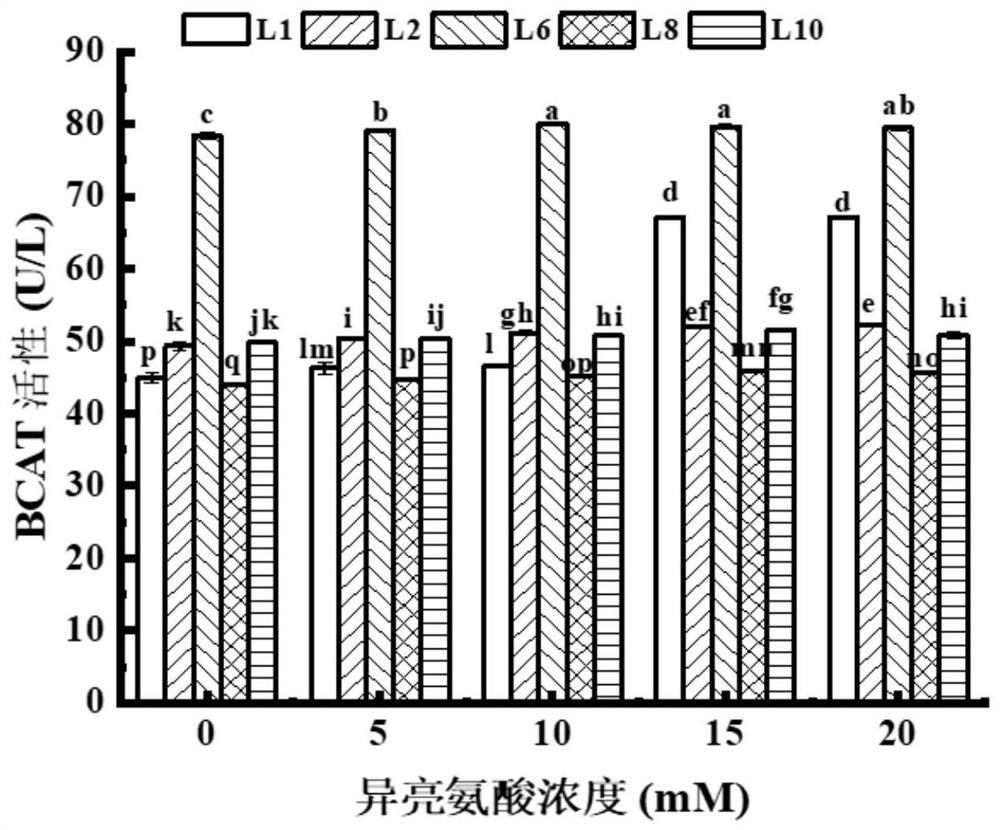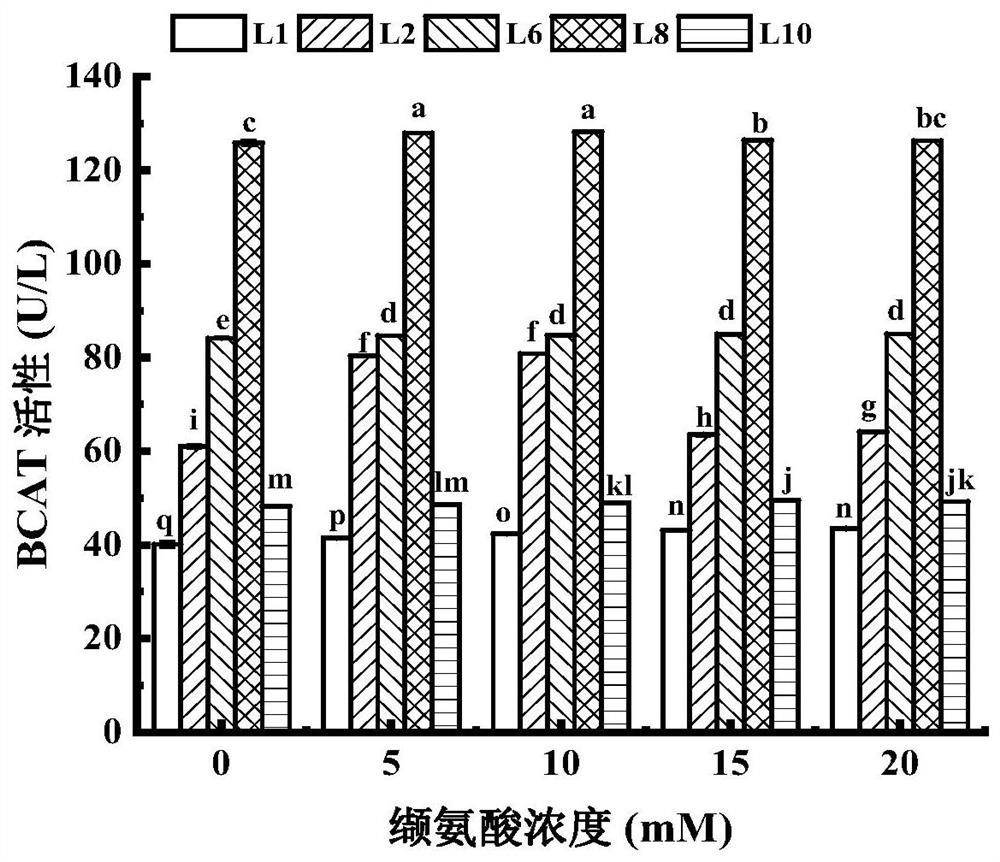Lactobacillus fermentum YZU-06 and application thereof
A YZU-06, Lactobacillus fermentum technology, applied in the field of microorganisms, can solve the problem of less research on screening high BCAT activity strains, and achieve the effect of accelerating the production rate
- Summary
- Abstract
- Description
- Claims
- Application Information
AI Technical Summary
Problems solved by technology
Method used
Image
Examples
Embodiment 1
[0038] Example 1 strain screening
[0039] The specific screening process is:
[0040] 1) First, 5 strains of lactic acid bacteria were obtained through preliminary screening, re-screening, determination of BCAAs metabolites of the strains, protease activity detection of the strains, basic fermentation test, acid production ability and growth curve measurement of the strains. The BCAT activity of 5 strains of lactic acid bacteria was tested, and the effects of leucine, isoleucine and valine on the BCAT activity of L1, L2, L6, L8 and L10 strains were as follows: Figure 1a , Figure 1b and Figure 1c shown. Different lowercase letters (a-q) in the figure indicate that the strains are significantly different (P<0.05) at different concentrations of BCAAs.
[0041]The results showed that strain L6 had the highest BCAT activity to leucine and isoleucine among the five strains (P<0.05). In addition, the concentration of BCAAs also had a significant effect on the BCAT activity of...
Embodiment 2
[0045] The performance measurement of embodiment 2 lactobacillus fermentum YZU-06
[0046] The performance of Lactobacillus fermentum YZU-06 is determined by comparing with Lactobacillus plantarum CGMCC 18217.
[0047] (1) Ability of the strain to degrade myofibrillar protein
[0048] Test method: Myofibrillar protein was subjected to sodium dodecyl sulfate-polyacrylamide gel electrophoresis (SDS-PAGE) to monitor the hydrolysis of the protein. Mix 540 μL of myofibrillar protein sample with 180 μL of 4× loading buffer (1% (w / v) bromophenol blue, 200 mM Tris-HCl pH 6.8, 8% (w / v) SDS, 40% (w / v) v) Glycerol and 1% (v / v) β-mercaptoethanol), then heated at 95°C for 10 min. After cooling to room temperature, 20 μL of the sample was added to the channel of the SDS-PAGE gel composed of 12.5% separating gel and 4% stacking gel. SDS-PAGE was carried out on the Mini-PROTEAN electrophoresis system under 90V constant voltage mode for 30 minutes, and then under 120V constant voltage mod...
Embodiment 3
[0061] Application of embodiment 3 Lactobacillus fermentum YZU-06 in fermented sausage
[0062] The preparation process of fermented sausage is as follows: every kilogram of pork is mixed according to the ratio of fat and lean 3:7, adding sugar 7%, salt 3%, monosodium glutamate 0.2%, five-spice powder 0.1%, ginger powder 0.15%, Daqu 20mL / kg, etc. Excipients, water 10% and strain inoculum 1×10 7 CFU / g, mixed evenly, followed by enema and ligation, and finally fermented for 28 days. The fermentation condition is: natural air drying. The sausages in the 12 treatment groups were selected at 0d, 7d, 14d, 21d, and 28d, respectively, and 50.0 g of each group was sampled each time, and stored in a freezer (-20°C).
[0063] Fermented sausage treatment group setup:
[0064] The first group: blank (CK) without adding leucine and strains without inoculation;
[0065] The second group: the treatment group (CK-1) that adds the leucine of 1mmol / kg but does not inoculate;
[0066] The th...
PUM
 Login to View More
Login to View More Abstract
Description
Claims
Application Information
 Login to View More
Login to View More - R&D
- Intellectual Property
- Life Sciences
- Materials
- Tech Scout
- Unparalleled Data Quality
- Higher Quality Content
- 60% Fewer Hallucinations
Browse by: Latest US Patents, China's latest patents, Technical Efficacy Thesaurus, Application Domain, Technology Topic, Popular Technical Reports.
© 2025 PatSnap. All rights reserved.Legal|Privacy policy|Modern Slavery Act Transparency Statement|Sitemap|About US| Contact US: help@patsnap.com



